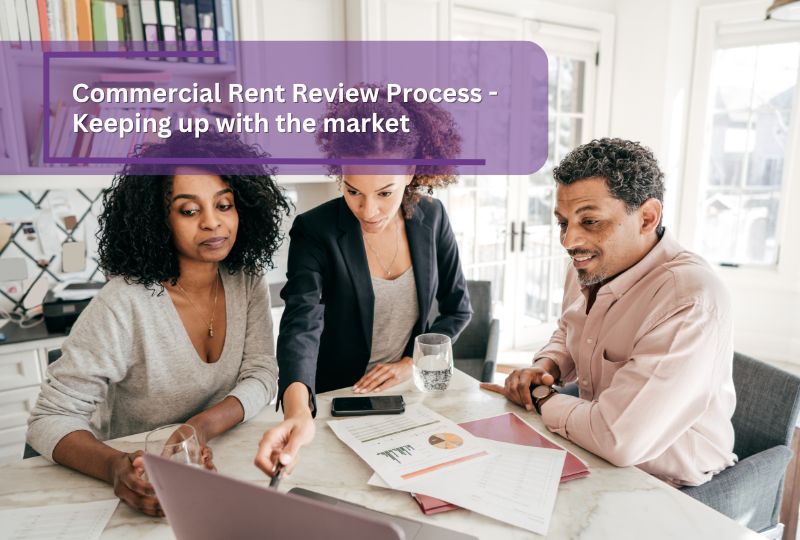Maintaining rental income in line with market conditions is essential for safeguarding the value of your commercial property investment. The commercial rent review process is a key mechanism that enables landlords to periodically reassess and adjust rent levels throughout the lease term.
This guide outlines the importance of rent reviews, the types commonly used in Scottish leases, and the procedural steps involved—ensuring you remain informed and well-positioned to manage your property portfolio effectively.
What Is a Commercial Property Rent Review?
A commercial rent review is a contractual provision within a lease that allows the landlord to revise the rent at specified intervals—typically every three to five years. Its purpose is to ensure the rent remains consistent with prevailing market rates.
Unlike residential tenancies, commercial rent reviews are governed by the terms of the lease, particularly the rent review clause. This clause defines the timing, methodology, and dispute resolution process. In Scotland, it is common for leases to include an upward-only rent review, meaning the rent may increase or remain static, but cannot decrease—even if market values fall.
Why Are Rent Reviews Important?
For Landlords
Rent reviews are essential for preserving the capital value and income potential of a commercial asset. Without them, landlords risk being tied to outdated rental figures, which can significantly impact long-term returns.
For Tenants
Although rent reviews may result in increased costs, they offer a structured and predictable framework for rent adjustments. A well-drafted clause can also protect tenants from arbitrary or excessive increases.
Common Types of Commercial Rent Reviews
The lease should clearly specify the method used to calculate revised rent. Common approaches include:
Open Market Rent Review
The most prevalent method, this bases the revised rent on the market value of comparable properties at the review date. A chartered surveyor typically conducts the valuation, applying assumptions (e.g., the property is in good repair) and disregards (e.g., tenant improvements) as outlined in the lease.
Index-Linked Rent Review
Rent is adjusted in line with a recognised index such as the Retail Prices Index (RPI) or Consumer Prices Index (CPI). This method offers transparency and predictability but may result in significant increases during inflationary periods.
Fixed or Stepped Rent Review
The lease specifies predetermined increases at set intervals. This provides certainty for both parties and simplifies financial planning.
Turnover Rent Review
Used primarily in retail leases, this method combines a base rent with a percentage of the tenant’s turnover. It aligns the landlord’s income with the tenant’s business performance.
The Commercial Rent Review Process
While the lease governs the specifics, the general process typically includes:
1. Notice of Review
The landlord initiates the process by serving formal notice to the tenant, usually several months before the review date.
2. Rent Assessment
A market assessment is conducted to determine the appropriate rent. This involves analysing comparable properties and applying the lease’s review methodology. The proposed rent is then communicated to the tenant.
3. Negotiation
Tenants may accept the proposal or respond with a counter-notice. Both parties often appoint surveyors to negotiate on their behalf.
4. Dispute Resolution
If agreement cannot be reached, the lease will specify a resolution method:
- Independent Expert: A qualified surveyor makes a binding decision.
- Arbitration: An arbitrator hears both sides and issues a binding determination.
5. Documentation
Once agreed, the new rent is recorded in a Rent Review Memorandum, which includes:
- The review date
- The revised rent
- The effective date of the new rent
This document should be completed even if the rent remains unchanged, to confirm the review has taken place.
Conclusion
A well-managed commercial rent review process is vital for maintaining the financial health of your property investment. By understanding the mechanisms and ensuring your lease agreements are robust and professionally drafted, you can protect your interests and foster constructive landlord-tenant relationships.
For complex reviews or high-value assets, engaging a qualified surveyor or legal advisor is strongly recommended.
Have A Question or Need Some Help?
Whether you're searching for the perfect rental property or a landlord wanting advice on letting, we're here to assist. Feel free to call our office or send us an email, and we'll be happy to help you with any queries you may have.
Frequently Asked Questions
Can a commercial rent review become outdated?
Yes. If a rent review hasn’t been carried out as outlined in the lease, the rent may no longer reflect the current market value. This can result in landlords receiving below-market rent or tenants paying more than necessary. In Scotland, regular reviews (usually every 3–5 years) help keep rent fair and aligned with market trends.
What is considered a fair commercial rent review in Scotland?
A fair review ensures the rent reflects the current market value of the property while following the terms of the lease. In Scottish leases, a well-drafted clause guides how the rent is calculated and helps maintain transparency, preventing disputes between landlord and tenant.
What is a reasonable commercial rent increase in Scotland?
Reasonable increases depend on the lease type and market conditions. Common methods in Scotland include open market reviews, index-linked increases, or fixed/stepped rent. The increase should balance the landlord’s income needs with tenant affordability, and upward-only clauses are common.
How often should a commercial rent be reviewed?
In Scotland, commercial rent is typically reviewed every 3 to 5 years, as stated in the lease. Regular reviews protect the landlord’s investment and ensure rent stays in line with local market rates.
Who pays for a commercial rent review?
Costs usually depend on the lease. Often, each party pays for its own surveyor and legal fees, but some leases may allow the sharing of costs. Always check the lease agreement for specific arrangements.



 Find a Property Sale/Rent
Find a Property Sale/Rent  Letting Agents
Letting Agents  Asset Management
Asset Management 






